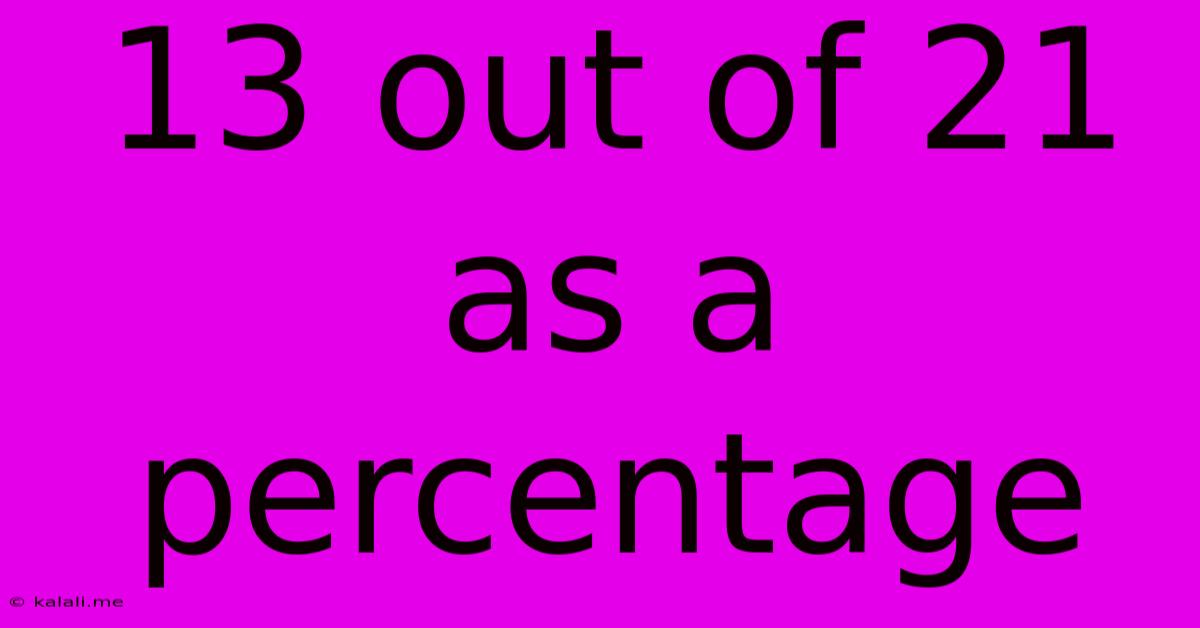13 Out Of 21 As A Percentage
Kalali
May 10, 2025 · 2 min read

Table of Contents
13 out of 21 as a Percentage: A Simple Guide to Percentage Calculations
Calculating percentages is a fundamental skill with applications across numerous fields, from finance and statistics to everyday life. This article provides a clear and concise explanation of how to determine what percentage 13 out of 21 represents, along with the broader concept of percentage calculations. Understanding this process is vital for anyone needing to interpret data or solve problems involving proportions. This guide will equip you with the knowledge to perform similar calculations independently.
Understanding Percentages
A percentage is a way of expressing a number as a fraction of 100. The symbol "%" is used to represent "percent." For instance, 50% means 50 out of 100, or one-half. Calculating percentages often involves converting fractions or ratios into their equivalent percentage representation.
Calculating 13 out of 21 as a Percentage
To find the percentage that 13 represents out of 21, we follow these steps:
-
Form a fraction: Express the problem as a fraction: 13/21
-
Convert the fraction to a decimal: Divide the numerator (13) by the denominator (21): 13 ÷ 21 ≈ 0.619
-
Convert the decimal to a percentage: Multiply the decimal by 100: 0.619 x 100 = 61.9%
Therefore, 13 out of 21 is approximately 61.9%.
Rounding Percentages
In many cases, you'll need to round your percentage to a certain number of decimal places. For example, you might round 61.9% to 62% for simplicity. The level of precision required depends on the context of your calculation. Rounding should always be done thoughtfully to maintain accuracy while improving readability.
Practical Applications of Percentage Calculations
Understanding percentage calculations is crucial in various situations:
- Grade calculations: Determining your final grade in a course often involves calculating percentages of different assignment scores.
- Financial calculations: Interest rates, discounts, and tax calculations all rely heavily on percentage calculations.
- Data analysis: Percentages are essential for interpreting data in charts and graphs, simplifying the understanding of complex datasets.
- Probability and statistics: Percentages are frequently used to express probabilities and statistical measures.
Beyond 13 out of 21: Mastering Percentage Calculations
The method described above can be applied to any similar problem. Simply replace 13 and 21 with your desired numerator and denominator. Practice is key to mastering percentage calculations; the more you practice, the more confident and efficient you'll become. Remember to always double-check your work, especially when dealing with important calculations. Using a calculator can significantly improve accuracy and speed.
This guide provides a comprehensive understanding of calculating percentages, specifically addressing the question of 13 out of 21 as a percentage. By mastering these fundamental principles, you'll be well-equipped to handle a wide range of percentage-related problems.
Latest Posts
Latest Posts
-
How Long Does It Take To Drive 2000 Miles
Jul 18, 2025
-
How Many Grams In A Teaspoon Of Cinnamon
Jul 18, 2025
-
How Long To Heat Water In Microwave
Jul 18, 2025
-
40 Oz Of Water Is How Many Cups
Jul 18, 2025
-
How Many Eighths In A Quarter Pound
Jul 18, 2025
Related Post
Thank you for visiting our website which covers about 13 Out Of 21 As A Percentage . We hope the information provided has been useful to you. Feel free to contact us if you have any questions or need further assistance. See you next time and don't miss to bookmark.